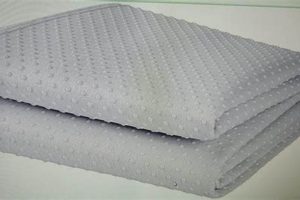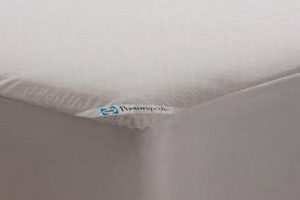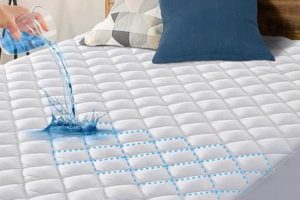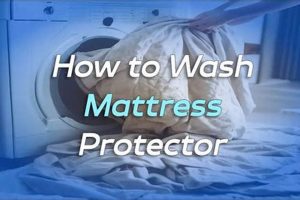An encasement designed to shield a queen-sized bed’s sleeping surface from liquids, allergens, dust mites, and general wear and tear. These protective layers typically feature waterproof or water-resistant materials and are fitted to the dimensions of a standard queen mattress. A common example would be a fitted sheet style cover made from polyurethane-laminated fabric.
The utilization of such a shield offers multiple advantages. It can extend the lifespan of the underlying sleep surface by preventing stains and damage. Furthermore, these coverings contribute to improved hygiene by acting as a barrier against allergens and dust mites, potentially benefiting individuals with sensitivities. Historically, rudimentary forms of mattress protection have existed, but modern materials and manufacturing processes have significantly enhanced their efficacy and comfort.
The following sections will delve into the different types available, examining their material compositions, specific features, and maintenance considerations to aid in selecting the optimal product for individual requirements.
Tips for Selecting a Queen Bed Mattress Protector
Choosing the correct protective layer for a queen mattress involves considering several factors to ensure optimal performance and longevity. The following guidelines offer insights into making an informed purchase.
Tip 1: Material Composition Assessment: Evaluate the materials used in construction. Options range from cotton and polyester blends to more specialized materials like polyurethane laminates or breathable membranes. Material selection influences breathability, water resistance, and overall comfort.
Tip 2: Waterproof vs. Water-Resistant Differentiation: Understand the difference. Waterproof options provide an impermeable barrier against liquids, while water-resistant models offer limited protection. Assess specific needs based on potential spills or incontinence concerns.
Tip 3: Allergen Barrier Properties: Examine the protector’s ability to block allergens and dust mites. Tightly woven fabrics and specialized membranes can effectively minimize allergen penetration, which is crucial for allergy sufferers.
Tip 4: Fit and Securement Considerations: Ensure the protector fits the queen mattress precisely and securely. Fitted sheet styles with elasticized edges offer reliable securement, preventing shifting and maintaining a smooth sleep surface.
Tip 5: Breathability Evaluation: Prioritize breathability to prevent overheating during sleep. Materials with good airflow can regulate temperature and enhance comfort.
Tip 6: Maintenance and Cleaning Requirements: Consider the ease of cleaning and maintenance. Machine-washable protectors simplify upkeep and ensure continued hygiene.
Tip 7: Noise Level Assessment: Some protectors, particularly those with waterproof layers, may generate noise during movement. Review product descriptions or customer feedback to gauge noise levels.
Tip 8: Certifications and Standards: Look for certifications, such as OEKO-TEX, which indicate that the product has been tested for harmful substances. This can provide reassurance regarding product safety and quality.
By considering these points, consumers can select a shield that effectively safeguards their mattress, promotes hygiene, and contributes to a more comfortable and restful sleep environment.
The subsequent sections will explore the common questions regarding the application and care of such protective measures.
1. Protection
The core function of a queen bed mattress protector resides in the provision of protection. This protection extends to various aspects of the mattress itself, including safeguarding against liquid spills, staining agents, allergens, dust mites, and general wear and tear. The efficacy of this protection directly impacts the lifespan and hygiene of the mattress. For instance, a sudden spill of coffee, if not immediately addressed, can permeate the mattress layers, leading to irreversible staining, odor, and potential mold growth. A mattress protector acts as a barrier, preventing the liquid from reaching the mattress core and minimizing the risk of such damage. This is particularly crucial for maintaining warranty validity, as many warranties are voided by liquid damage.
The protective qualities also extend to safeguarding the sleeper. By acting as a barrier against allergens and dust mites, the shield contributes to a healthier sleep environment, which is of significant importance for individuals with allergies or asthma. Consider the example of a household with pets. Pet dander, a potent allergen, can easily accumulate within mattress fibers. A protector reduces the penetration of dander, thus decreasing the likelihood of allergic reactions during sleep. Furthermore, many mattress protectors offer protection against bed bugs, preventing infestation and the associated costs and inconveniences of eradication. The design and material composition are key to achieving effective shielding, with tightly woven fabrics and specialized waterproof layers offering enhanced defense.
In summary, the protection offered by a mattress shield is integral to its purpose and value. It not only preserves the physical integrity and aesthetic appeal of the mattress but also contributes to a healthier and more hygienic sleep surface. The practical significance lies in the prevention of damage, the mitigation of allergens, and the safeguarding of both the mattress investment and the sleeper’s well-being. However, it is important to recognize that not all protectors offer equal levels of defense; careful consideration of material, construction, and specific needs is essential for selecting an appropriate and effective product.
2. Hygiene
The concept of hygiene is inextricably linked to queen bed mattress protectors. These accessories play a significant role in maintaining a clean and healthy sleep environment, directly influencing the overall well-being of individuals. This relationship extends beyond mere cleanliness to encompass allergen control and the prevention of microbial growth.
- Barrier Against Contaminants
A primary function is acting as a barrier against various contaminants. These include bodily fluids such as perspiration, saliva, and accidental spills, as well as dust mites, allergens, and dead skin cells. Without this barrier, these substances can penetrate the mattress, creating a breeding ground for bacteria and contributing to unpleasant odors. A protector can be easily removed and laundered, thereby preventing the accumulation of these contaminants within the mattress itself. For example, an individual who perspires heavily during sleep would benefit from a protector that prevents moisture from soaking into the mattress, thus inhibiting bacterial growth.
- Allergen Control
These protectors are particularly beneficial for individuals with allergies or asthma. Dust mites, a common allergen found in mattresses, can trigger allergic reactions and respiratory issues. Many protectors are designed with tightly woven fabrics that prevent dust mites from penetrating the mattress fibers, effectively reducing allergen exposure. Similarly, the protector can act as a barrier against pet dander and other allergens that may be present in the bedroom environment. Regular cleaning of the protector further eliminates accumulated allergens, contributing to a healthier sleep environment.
- Prevention of Microbial Growth
Moisture and organic matter within a mattress can create an ideal environment for microbial growth, including bacteria and mold. This can lead to unpleasant odors, discoloration, and potential health risks. A protector, particularly one with waterproof or water-resistant properties, can prevent moisture from reaching the mattress core, thereby inhibiting microbial growth. Furthermore, some protectors are treated with antimicrobial agents that further inhibit the growth of bacteria and fungi.
- Easy Maintenance and Cleaning
The ease of cleaning and maintaining a mattress protector directly contributes to its hygienic benefits. Most protectors are machine washable, allowing for convenient and regular cleaning. This is in contrast to mattresses, which are difficult to clean thoroughly and are often susceptible to permanent staining and odor retention. Regular washing of the protector removes accumulated contaminants and allergens, ensuring a clean and hygienic sleep surface. The ease of maintenance encourages frequent cleaning, further promoting a healthy sleep environment.
In conclusion, the implementation of these shields significantly enhances the hygienic aspects of a sleeping environment. By serving as a barrier against contaminants, controlling allergens, preventing microbial growth, and facilitating easy maintenance, these protectors contribute to a cleaner, healthier, and more comfortable sleep experience. The choice of material and construction should align with individual needs and preferences to maximize the hygienic benefits.
3. Comfort
Comfort, while not the primary function of a queen bed mattress protector, represents a critical consideration impacting user satisfaction. The relationship between comfort and these protectors is multifaceted, influenced by material selection, design, and compatibility with the underlying mattress. An ill-chosen protector can negatively impact sleep quality, negating the benefits of a high-quality mattress. For instance, a protector constructed from a non-breathable material can trap heat, leading to discomfort and disrupted sleep. Conversely, a protector utilizing soft, breathable fabrics such as cotton or bamboo can enhance the sleeping experience by promoting airflow and wicking away moisture. Ultimately, the protector should augment, not detract from, the comfort provided by the mattress.
The impact on comfort extends beyond thermal regulation. The texture and feel of the protector directly influence the tactile experience. A protector with a rough or noisy surface can be disruptive, particularly for light sleepers. In contrast, a smooth and quiet protector can be virtually imperceptible, allowing the sleeper to focus on the comfort of the mattress itself. Furthermore, the fit of the protector plays a crucial role. A poorly fitted protector can shift and bunch, creating pressure points and discomfort. A properly fitted protector, on the other hand, will remain securely in place, providing a smooth and even surface. Real-world examples include individuals with sensitive skin finding relief from irritation by using protectors made from hypoallergenic and smooth materials, and others reporting improved sleep quality due to reduced noise from a properly fitted, quiet protector.
In summary, while the primary purpose of a queen bed mattress protector is to safeguard the mattress, comfort is an indispensable element of its overall value. A protector that compromises comfort undermines its potential benefits. Selecting a protector with appropriate materials, breathable construction, and a secure fit is paramount to ensuring a comfortable and restful sleep experience. Balancing the need for protection with the desire for comfort is a key challenge in the selection process, highlighting the importance of informed decision-making.
4. Longevity
The correlation between a queen bed mattress protector and mattress longevity is direct and consequential. A mattress, representing a significant financial investment, is susceptible to damage from various sources. A protector acts as a preventative measure, mitigating these potential threats and, consequently, extending the lifespan of the underlying mattress. Damage from liquid spills, the accumulation of dust mites, and the general wear and tear associated with regular use contribute to the degradation of mattress materials over time. Without a protective barrier, these factors accelerate the aging process and diminish the mattress’s structural integrity and comfort. The presence of a mattress protector, therefore, constitutes a proactive approach to preserving the mattress’s condition and maximizing its useful life.
The practical implications of enhanced longevity are multifaceted. First, it translates to direct cost savings by delaying the need for mattress replacement. Given the expense associated with purchasing a new queen-sized mattress, extending its lifespan by several years represents a substantial financial benefit. Second, it contributes to environmental sustainability by reducing the frequency of mattress disposal. Mattresses occupy significant landfill space, and their decomposition can release harmful chemicals into the environment. By prolonging the lifespan of a mattress, a protector helps minimize its environmental impact. Furthermore, maintaining a mattress in good condition ensures consistent sleep quality over a longer period. A degraded mattress can lose its support and comfort, leading to sleep disturbances and potential health issues. A protector helps preserve the mattress’s original qualities, ensuring continued optimal sleep quality for an extended period. For example, a family with young children prone to spills and accidents would find a waterproof protector invaluable in preventing irreversible damage and maintaining the mattress’s structural integrity for years to come.
In conclusion, the relationship between queen bed mattress protectors and mattress longevity is undeniable. By providing a protective barrier against various threats, protectors directly contribute to extending the lifespan of the mattress, resulting in significant cost savings, environmental benefits, and the preservation of sleep quality. While the initial investment in a protector may seem incremental, the long-term return in terms of mattress preservation and extended use justifies its purchase. The challenge lies in selecting a protector that effectively balances protection, comfort, and breathability to maximize its overall value and contribution to mattress longevity.
5. Investment
The acquisition of a queen bed mattress protector constitutes a multifaceted investment, extending beyond the immediate purchase price. The primary investment lies in safeguarding a more substantial expenditure: the queen-sized mattress itself. Mattresses represent a significant household expense, and their lifespan is directly influenced by their level of protection from damage and wear. A mattress shield, therefore, serves as a form of insurance, minimizing the risk of premature degradation and the subsequent need for costly replacement. A common scenario involves accidental spills or stains, which, if absorbed into the mattress, can lead to permanent damage and void the manufacturer’s warranty. A protective layer effectively mitigates this risk, preserving the mattress’s condition and prolonging its useable life. The economic benefit is realized over time, as the protector delays the need to replace the mattress, resulting in significant cost savings. Consider a high-quality queen mattress priced at $1000; a $50 protector that extends its lifespan by 2-3 years translates to a substantial return on investment.
Furthermore, the investment extends to health and well-being. A mattress protector can create a cleaner and more hygienic sleep environment by acting as a barrier against allergens, dust mites, and bed bugs. This is particularly relevant for individuals with allergies or asthma, where exposure to these irritants can trigger respiratory issues and disrupt sleep. The cost of allergy medication and healthcare visits associated with poor sleep quality can be significant. By reducing exposure to allergens, a protector contributes to improved sleep quality and overall health, representing an investment in personal well-being. For example, families with children suffering from allergies may find that using a protector significantly reduces nighttime symptoms, leading to better sleep and improved daytime performance. The long-term benefits of a cleaner and healthier sleep environment far outweigh the initial cost of the protector.
In conclusion, viewing a queen bed mattress protector as an investment reveals its multifaceted value proposition. It protects a significant financial asset, contributes to improved health and well-being, and offers long-term economic benefits. The challenge lies in selecting a protector that effectively balances protection, comfort, and cost to maximize its return on investment. By considering these factors, consumers can make an informed decision that safeguards their financial resources, promotes their health, and ensures a comfortable and restful sleep experience.
Frequently Asked Questions
The following addresses common inquiries regarding the utilization and selection of queen bed mattress protectors. These answers aim to provide clarity and informed guidance.
Question 1: What distinguishes a “waterproof” protector from a “water-resistant” one?
A waterproof protector offers an impermeable barrier against liquids, preventing any fluid penetration. A water-resistant protector, conversely, provides a degree of protection but may allow some liquid to seep through over time or with significant spillage.
Question 2: How often should a queen bed mattress protector be cleaned?
It is recommended to launder the mattress protector every one to two months. More frequent cleaning may be necessary in cases of spills, accidents, or if the individual suffers from allergies.
Question 3: Can a queen bed mattress protector alter the feel of the underlying mattress?
Certain protectors, particularly those with thicker padding or specific textures, may slightly alter the feel. However, many modern protectors are designed to be thin and unobtrusive to minimize any noticeable change in comfort.
Question 4: Are all queen bed mattress protectors effective against bed bugs?
Not all protectors offer bed bug protection. To effectively prevent bed bug infestation, a protector must be specifically labeled as “bed bug proof” and feature a tightly woven fabric and secure zipper closure.
Question 5: What materials are commonly used in the construction of these protectors, and how do they differ?
Common materials include cotton, polyester, polyurethane laminates, and various synthetic blends. Cotton offers breathability, while polyester provides durability. Polyurethane laminates provide waterproof properties. The choice of material impacts comfort, water resistance, and overall longevity.
Question 6: Will using a queen bed mattress protector void a mattress warranty?
Using a protector will generally not void a mattress warranty. In fact, many warranties stipulate the use of a protector to prevent stains and damage, which can invalidate the warranty.
Understanding these key aspects enables informed decision-making when selecting and utilizing a protector, thereby maximizing its benefits.
The subsequent section will explore potential drawbacks associated with queen bed mattress protectors.
Conclusion
This exploration has elucidated the multifaceted role of the queen bed mattress protector. Beyond a simple barrier, it serves as a critical component in maintaining hygiene, extending mattress lifespan, and safeguarding investment. The informed selection, mindful of material composition, protective qualities, and comfort considerations, is paramount to realizing its full potential.
The continued reliance on such protective measures reflects an understanding of long-term value and responsible stewardship of resources. Prioritizing the integration of a suitable shield is not merely an addition, but a strategic decision for sustained quality and well-being within the sleep environment.




![Cool Tempur-Pedic Comfort: Cooling Mattress Protector [Guide] Organic & Natural Mattress Buyer’s Guide: Non-Toxic Sleep Solutions Cool Tempur-Pedic Comfort: Cooling Mattress Protector [Guide] | Organic & Natural Mattress Buyer’s Guide: Non-Toxic Sleep Solutions](https://mattressworldpa.com/wp-content/uploads/2025/07/th-2523-300x200.jpg)


